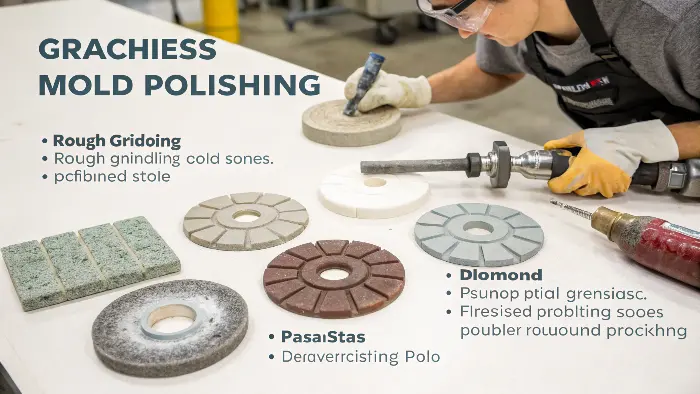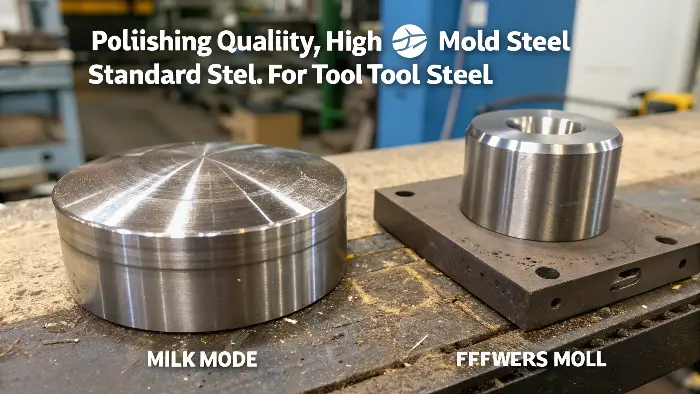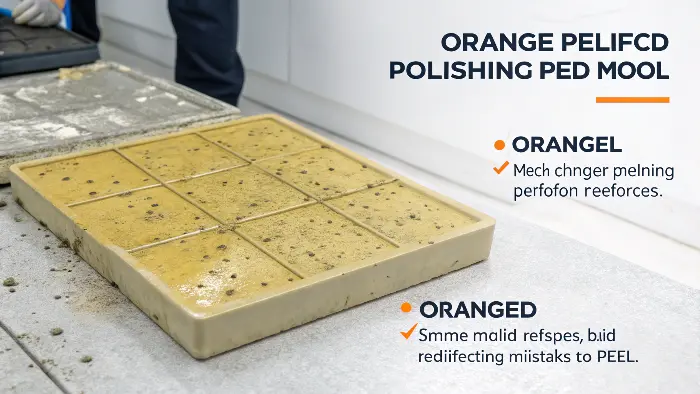Imperfect finishes ruining your parts? Frustrated by constant rework and delays? CKMOLD delivers flawless mold surfaces, ensuring your product quality and saving you those operational headaches.
At CKMOLD, we achieve superior surface finishes through a meticulous combination of skilled craftsmanship, advanced polishing tools, carefully selected abrasives, and stringent quality control. This multi-stage process, tailored to each mold’s specific material and requirements, ensures optimal results for your products every time.
You might be wondering what really goes into this. Believe me, it’s not just about rubbing a surface until it’s shiny; there’s a real science and, I’d say, an art to it. I’ve been in this industry for a long time, starting on the factory floor and later building my own company, and I’ve seen firsthand how critical this step is. So, let me walk you through how we approach this crucial stage at CKMOLD, because getting it right truly makes all the difference for your final product and your bottom line.
Why is a Perfect Mold Surface Finish Non-Negotiable for Your Product’s Success?
Tired of seeing those annoying surface defects on your plastic parts? More often than not, these issues trace right back to the mold’s surface. A flawless mold surface isn’t just a ‘nice-to-have’; it’s absolutely essential for your product’s aesthetic appeal and its functional integrity.
A perfect mold surface finish is non-negotiable because it directly translates to the quality of your final product. It impacts everything from appearance and part release to tool longevity and even the mechanical properties of the molded component. Think of it as an investment, not an expense.
Let me break this down a bit. When I talk to business owners like Michael, who are laser-focused on product quality and efficiency, the conversation often turns to how a superior mold finish can be a game-changer. It’s not just about looking good – though that’s a big part of it!
The Direct Impact on Part Aesthetics
This is probably the most obvious one. If you’re making consumer electronics, for example, the look and feel are paramount. Any imperfection on the mold surface – a tiny scratch, a dull spot – will be perfectly replicated on every single part. For high-gloss finishes, often referred to as SPI A-1 or A-2, the mold surface needs to be like a mirror. I’ve seen projects where a sub-par polish led to an entire batch of parts being rejected, purely on aesthetics. That’s a costly mistake, and it’s why we take such care.
Ensuring Smooth Part Ejection
A super smooth, well-polished surface means less friction when the plastic part is ejected from the mold. This might sound minor, but it has big implications. Smoother ejection reduces stress on the part, minimizing the risk of warpage, drag marks, or even breakage. It also means faster cycle times because parts release cleanly without sticking. For Michael, faster cycle times mean higher output and better cost efficiency.
Extending Mold Lifespan
Believe it or not, a good polish can also help your mold last longer. A properly polished surface is more resistant to corrosion and wear, especially with some of the more abrasive or corrosive plastics. When the surface is immaculate, there are fewer microscopic pits or crevices where trouble can start. We’re talking about protecting a significant investment here.
Functional Implications
Sometimes, the surface finish has functional requirements. For optical parts, clarity is key, demanding an optical-grade polish. For parts that need to seal, a smooth mating surface is critical. Any deviation can lead to product failure. So, you see, it’s way more than just shine.
What Key Polishing Stages Does CKMOLD Master for Flawless Surfaces?
Are you sometimes confused by all the different polishing grades and what they mean? Or maybe you’re unsure what level of finish your specific mold actually needs? It can be a bit of a maze. At CKMOLD, we try to demystify this process for our clients, guiding you to the perfect finish for your application.
CKMOLD masters key polishing stages, from initial rough grinding all the way to a true mirror finish if required. We meticulously progress through various grit sizes of stones, papers, and diamond pastes, ensuring each step perfectly prepares the surface for the next, ultimately achieving the specified SPI standard your project demands.

Achieving that perfect surface isn’t a single-step job; it’s a carefully orchestrated sequence. I often compare it to painting a masterpiece – you start with broad strokes and gradually refine down to the finest details. Skipping steps or rushing the process? That’s a recipe for disaster, leading to waves, orange peel, or hidden scratches that only show up at the very end. We’ve developed a robust methodology.
Stage 1: Initial Grinding and Shaping (Stone Polishing)
After machining, the mold cavity will have tool marks. The first step is to remove these and establish the basic geometry. We use coarse to medium grit abrasive stones, often with lapping machines or by hand for intricate areas. The goal here is to get a uniform, flat (or contoured, as designed) surface, removing any EDM scale or machine marks. This stage sets the foundation; if this isn’t right, nothing else will be.
Stage 2: Fine Sanding (Paper Polishing)
Once the stoning is done, we move to abrasive papers, starting with a grit that smoothly transitions from the last stone. We then work our way down through progressively finer grits – say, from 400 grit up to 1200 or even 2000 grit. The key here is to remove all scratches from the previous stage, changing the polishing direction with each grit to ensure complete coverage. This is where skill and patience really shine.
Stage 3: Lapping and Buffing (Diamond Paste Polishing)
This is where we start to see the real gloss develop. We use diamond pastes, again in decreasing micron sizes, applied with soft wood, felt bobs, or cloth. This stage refines the surface to a high sheen. For many commercial finishes (like SPI B-series), this might be close to the final step. It requires a very clean environment and meticulous technique to avoid embedding any stray particles.
Stage 4: Final Mirror Finish (Optical Polishing, if required)
| For the highest gloss, like SPI A-1 (mirror finish) or optical applications, we go even further. This often involves ultra-fine diamond pastes (e.g., 1-micron or even 0.5-micron) and specialized buffing techniques. It’s incredibly labor-intensive and requires our most skilled technicians. The result is a surface so smooth it’s flawless to the naked eye and under magnification. To give you an idea, here’s a simplified look at common SPI finishes: |
SPI Finish | Description | Typical Application | Polishing Method |
|---|---|---|---|---|
| D-1 to D-3 | Dull/Frosted/Satin | Non-critical surfaces, textured parts | Dry Blast (Glass Bead, Sand) | |
| C-1 to C-3 | Stone Polish (Matte) | Some industrial parts, low gloss needs | Fine Stone (e.g., 600 grit stone) | |
| B-1 to B-3 | Paper Polish (Semi-Gloss) | Medium gloss, many consumer products | Fine Emery Paper (e.g., 600 grit paper) | |
| A-1 to A-3 | Diamond Buff (High Gloss) | Mirror finish, lenses, high-end products | Diamond Buff (e.g., Grade #3 to #15 Diamond Buff) |
Understanding these stages and their outcomes is crucial for specifying the right finish for your parts, and that’s something we always discuss upfront with clients like Michael.
How Does Mold Steel Selection Impact the Final Polishing Outcome?
Ever wondered why some molds seem to polish up to a beautiful, brilliant shine with relative ease, while others fight you every step of the way, never quite reaching that perfect gleam? A huge part of the answer lies in the mold steel itself. I always say, choosing the right steel is the very first step towards achieving a great surface finish.
Mold steel selection critically impacts the final polishing outcome. Steels with high purity, uniform hardness, and fine grain structure, such as S136 or NAK80, allow for much higher gloss and defect-free surfaces compared to standard, less refined tool steels.

This is something I learned early in my career, sometimes the hard way! You can have the most skilled polisher in the world, but if the steel isn’t up to snuff for the desired finish, you’re setting them up for a real challenge, or even failure. It’s like trying to carve a detailed sculpture out of a piece of wood full of knots and imperfections.
Hardness and Polishability
Generally, harder steels can take a higher polish. However, they are also more difficult and time-consuming to polish. So, there’s a balance. Steels like S136 (a stainless type) can be hardened to around 50-52 HRC and are renowned for their excellent polishability, making them ideal for mirror finishes on parts that need corrosion resistance. Pre-hardened steels like P20 are easier to machine but typically won’t achieve the same super-high gloss as a through-hardened, high-purity steel. NAK80 is another popular choice; it’s a pre-hardened steel (around 40 HRC) that offers a surprisingly good polish, often up to an SPI A-2, due to its clean composition.
Inclusions and Impurities
This is a big one. Non-metallic inclusions (like sulfides, oxides, silicates) within the steel matrix are an enemy of high-quality polishing. During polishing, these tiny impurities can be dislodged, leaving pits or streaks. Or, they might be harder or softer than the surrounding steel, leading to an uneven surface. This is why steels produced using processes like Electro-Slag Remelting (ESR) are preferred for critical polishing jobs. ESR helps to remove these impurities, resulting in a much cleaner, more homogenous steel. You can really tell the difference when you’re aiming for that A-1 finish.
Grain Structure
A fine, uniform grain structure is also essential. Coarse or inconsistent grains can lead to an "orange peel" effect after polishing, especially on softer steels. The uniformity ensures that the material abrades consistently, allowing for a smoother, more even surface.
CKMOLD’s Steel Recommendation Approach
When a client like Michael comes to us, we don’t just ask "What finish do you want?" We ask about the part’s application, the type of plastic being molded, expected production volume, and of course, the desired surface finish. Based on all this, we recommend the most suitable steel. It might be a slightly higher upfront cost for a premium steel, but it often saves money in the long run through easier polishing, better part quality, and longer mold life. It’s about making the smart choice from the very beginning.
What Common Polishing Pitfalls Can Ruin Your Mold, and How Do We Sidestep Them?
Are you sometimes worried about those common polishing mistakes you hear about, like "orange peel," drag marks, or uneven finishes? These defects aren’t just unsightly; they can be incredibly costly, leading to part rejection, mold rework, and production delays. At CKMOLD, our years of experience have taught us how to anticipate and avoid these frustrating and expensive problems.
Common polishing pitfalls include over-polishing (especially on edges), inconsistent pressure leading to waviness, using the wrong abrasives for the steel type, or creating "orange peel" and "drag marks." At CKMOLD, we sidestep these through highly skilled technicians, strictly controlled processes, and thorough inspection at each stage, proactively preventing costly rework.

I’ve seen my share of molds that came to us for "rescue" after a bad polishing job elsewhere. It’s always tougher to fix a problem than to prevent it in the first place. That’s why vigilance and expertise are so critical in the polishing room. Here are some of the troublemakers we’re always on guard against:
The Dreaded "Orange Peel"
This looks just like it sounds – a dimpled, uneven surface texture resembling an orange’s skin. It often happens when polishing softer steels, or if the polishing direction isn’t varied enough, or if too much pressure is applied with buffing wheels. It’s a sign that the metal surface has been disturbed rather than smoothly abraded. Our technicians are trained to recognize the early signs and adjust their technique immediately.
Scratches and Drag Marks
These are probably the most common issues. A stray piece of grit, a contaminated polishing cloth, or simply using too coarse an abrasive for too long can leave deep scratches. Drag marks occur when a piece of dislodged metal or abrasive gets trapped and dragged across the surface. The solution? Meticulous cleanliness, progressing patiently through grit sequences, and careful inspection under good lighting at every step. It sounds simple, but it demands discipline.
Over-Polishing and Edge Dubbing
You can actually polish too much! Over-polishing, especially on sharp edges or intricate details, can round them off or "dub" them. This can alter the part’s dimensions or fit. This is where the "art" of polishing comes in – knowing just how much material to remove and when to stop. Our polishers develop a feel for this that only comes with experience. For delicate features, we often use custom-shaped tools and a very light touch.
CKMOLD’s Proactive Prevention Strategies
How do we avoid these? It’s not magic, it’s methodology.
- Training: Continuous training for our technicians on different steels, new abrasive technologies, and defect recognition.
- Controlled Environment: Our polishing area is kept clean to minimize contamination.
- Right Tools for the Job: Using appropriate stones, papers, pastes, and lapping tools for each specific steel and finish. We don’t cut corners here.
- Step-by-Step Inspection: We inspect the surface after each grit stage, often using magnification. It’s much easier to correct a small issue early than a big one later.
- Communication: Clear understanding of the client’s requirements (like Michael’s need for consistent quality) from the get-go.
By focusing on these areas, we prevent these pitfalls rather than having to fix them later. It’s all about delivering that perfect mold surface the first time.Conclusion
In essence, achieving superior surface finishes at CKMOLD is a blend of art, science, and meticulous process. It ensures your products look great, perform flawlessly, and your manufacturing runs smoothly. We’re committed to this.
